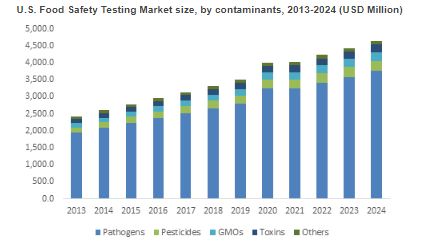
By Global Market Insights
Increasing threats over food consumption have stimulated the global food safety testing market and generated demand for effective test products that can ensure food safety. Food supply worldwide is facing a range of risks including environmental toxins, bacteria, and food allergens. The food safety testing industry has been growing substantially, owing to the increasing threat of foodborne illness and stringent food safety regulations. Moreover, expansion of import and export business of food supply across the globe is expected to further boost the demand for the food safety testing market. According to Global Market Insights, Inc., “The Food Safety Testing Market, worth $9 billion in 2015, is estimated to grow at a CAGR of 7% over the period of 2016-2024.” Food safety testing industry growth will also be influenced by the expansion of the global processed food industry which is anticipated to surpass $7 trillion by 2024.
The most common source for contamination of food is pathogens. These pathogens can cause various gastrointestinal disorders such as abdominal cramps, vomiting, diarrhea, and nausea, leading to an increase in illnesses and deaths of around 2 million people every year. The growing food epidemic has mandated laboratory testing for Salmonella, Listeria, E. coli, and Campylobacter, in turn making the food pathogen testing market a major revenue pocket accounting for 30% of the global demand. Pesticides are another type of contaminant causing health disorders. The pesticide food safety testing market, worth $800 million in 2015, will witness substantial growth, owing to regulatory norms for using certified and organic pesticides.
Contaminated food is a very serious issue which may result in demise. As per WHO’s statistical report in 2014, over 2.5 million people died due to diarrheal diseases. Moreover, the U.S. is facing an alarming rate of increase in foodborne illness, resulting in nearly 5,000 deaths and more than 325,000 hospitalizations every year. This has generated the need to implement quality and safety checks, where consumers have the authority to trace their ready-to-eat meals, processed products, bakery, and preserved and canned products. In this regard, the EU and the FDA have given conformities with consumers’ rights to track food through all production and distribution stages, in turn driving the food safety testing industry. In addition, major food regulatory bodies and authorities such as Good Hygiene Practices (GHP), Good Manufacturing Practices (GMP), Hazard Analysis Critical Control Point (HACCP), and Good Agricultural Practices (GAP), are extending extensive support in ensuring food authenticity, thereby propelling the food safety testing market growth.
The food safety testing technology market has witnessed a noticeable shift towards the rapid food safety testing technology market from the time-consuming traditional food safety testing industry. Biosensors, ELISA, rapid culture detection, and PCR-based techniques are widely adopted technologies used to examine the count, metabolites, and type of microorganisms.
The growth of the food safety testing market is also poised to benefit from the increasing consumption of meat, poultry, and dairy products. Unhygienic conditions while skinning and handling animals in slaughterhouses is the key responsible factor favoring the meat and poultry food safety testing market. Similarly, dairy products can also get easily contaminated through infected animals. Regulatory bodies such as the FSIS and HACCP are taking major steps in preventing meat and poultry product contamination and implementing adequate pasteurization of dairy products, stimulating the food safety testing industry share.
The European food safety testing market is valued over $2.5 billion in 2015, with the U.K. and Germany leading the regional demand. Increasing consumer awareness and stringent food safety regulations will boost demand for the European food safety testing market over the coming years. The Asia Pacific food safety testing industry will emerge rapidly due to rising population, growing demand for food products, and increasing stringent regulations for food safety. China, being the major export trade market, is anticipated to witness an annual growth rate of 11% over the period of 2016-2024.
The food safety testing market is consolidated, with the top three players sharing 45% of the overall business space. The key industry participants include Intertek, Bureau Veritas, SGS, Det Norske Veritas, Eurofins Laboratories, Idexx Laboratories, ALS Laboratory, and Bio-Rad Laboratories.







